A Comprehensive Report on Service Oriented Computing and e-Business
VerifiedAdded on 2020/07/22
|10
|1619
|109
Report
AI Summary
This report provides a comprehensive overview of Service Oriented Computing (SOC) and its crucial role in e-business. It begins by defining SOC and exploring its relationship with Service Oriented Architecture (SOA), emphasizing how SOA facilitates service discovery, combination, and utilization, thereby addressing the challenges of distributed enterprise computing. The report then delves into the practical applications of SOA in businesses and e-businesses, highlighting its ability to provide a competitive advantage by enabling rapid market responses, simplifying integration, and offering flexibility in payment services. The report also discusses how SOA allows businesses to provide new consumer experiences and generate new offerings, ultimately driving the future of electronic commerce. The report references multiple sources to support the concepts discussed, including the use of SOA in e-commerce and the benefits of adopting SOA techniques for service suppliers and software companies. The conclusion reiterates the benefits of SOA in reducing friction in payment enabling, facilitating new services, and driving the future of e-commerce.
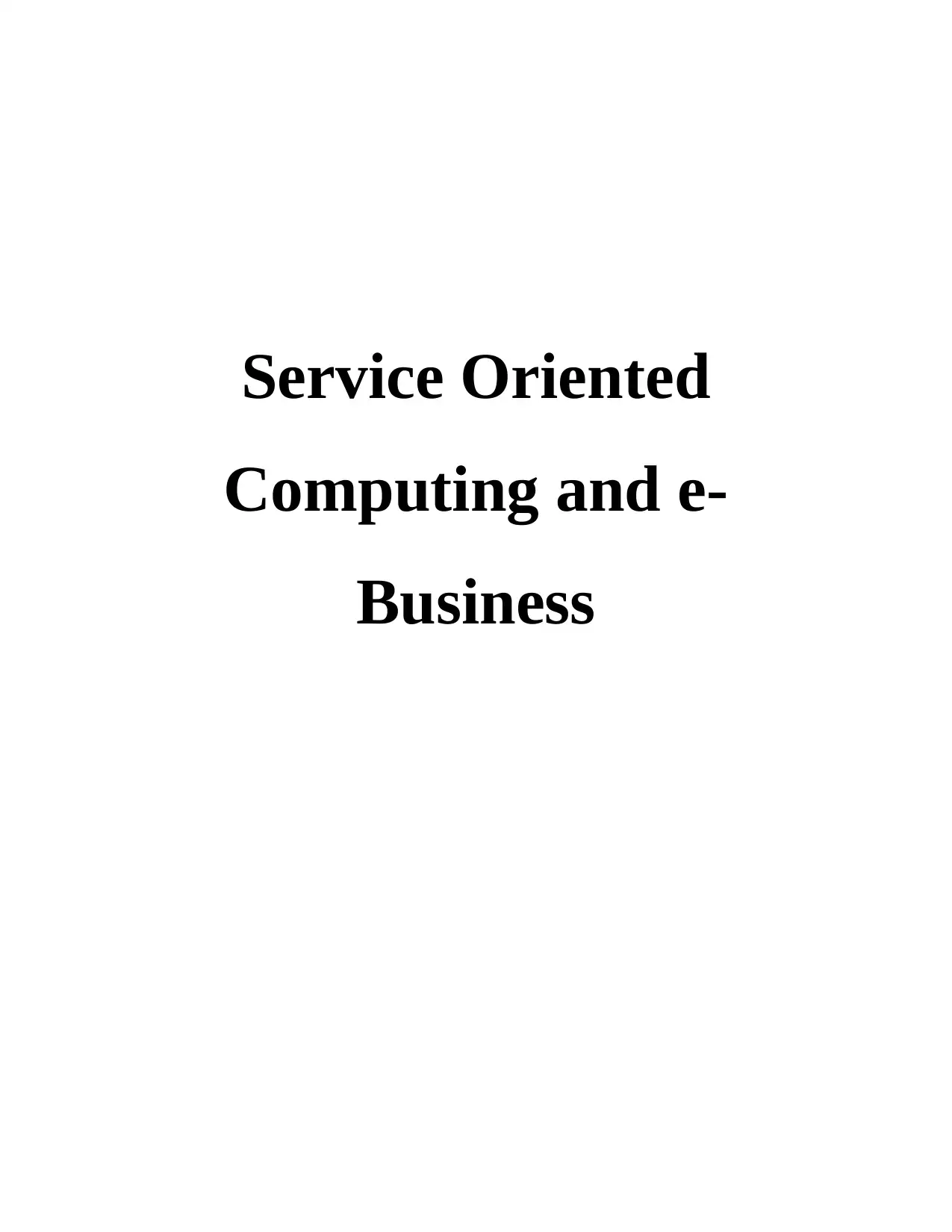
Service Oriented
Computing and e-
Business
Computing and e-
Business
Paraphrase This Document
Need a fresh take? Get an instant paraphrase of this document with our AI Paraphraser
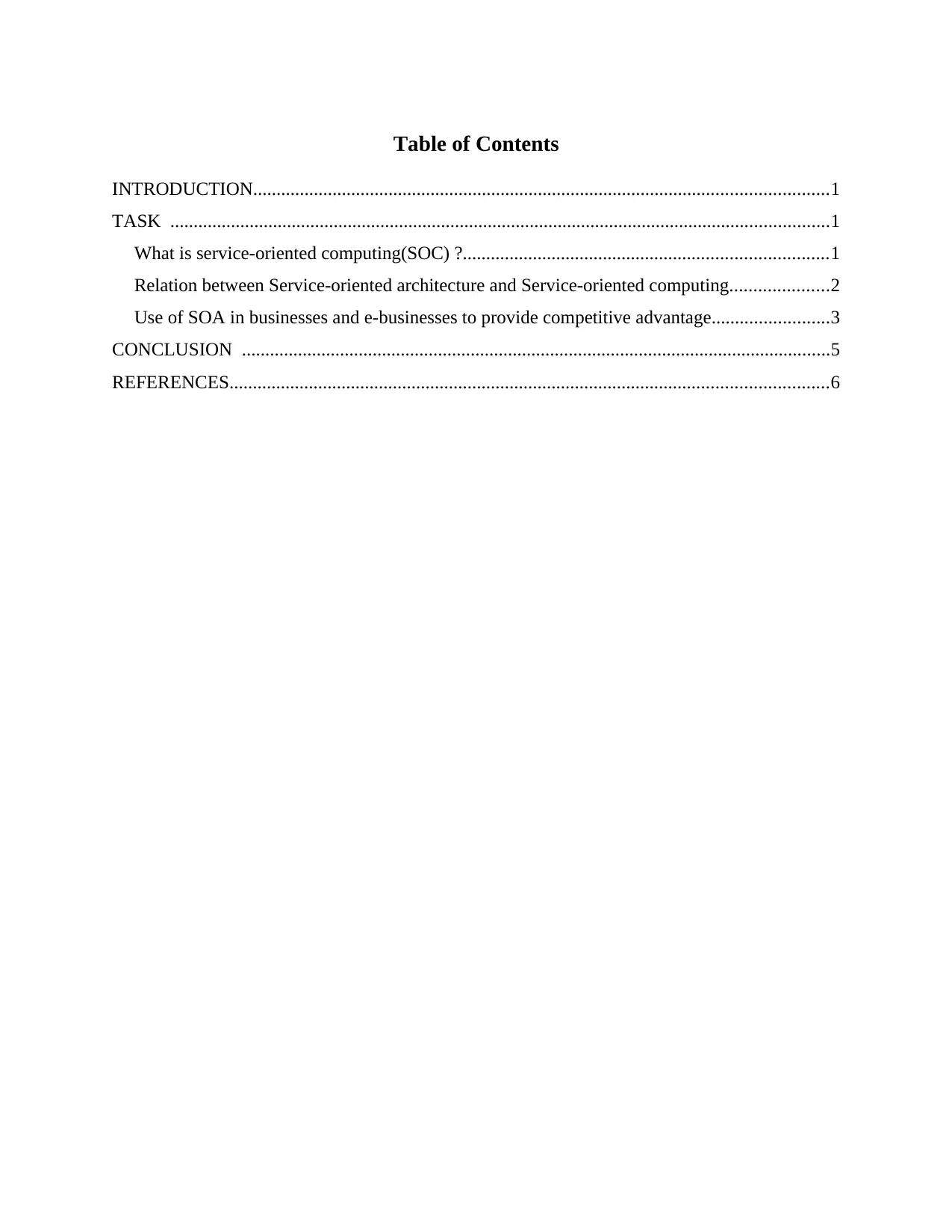
Table of Contents
INTRODUCTION...........................................................................................................................1
TASK .............................................................................................................................................1
What is service-oriented computing(SOC) ?..............................................................................1
Relation between Service-oriented architecture and Service-oriented computing.....................2
Use of SOA in businesses and e-businesses to provide competitive advantage.........................3
CONCLUSION ..............................................................................................................................5
REFERENCES................................................................................................................................6
INTRODUCTION...........................................................................................................................1
TASK .............................................................................................................................................1
What is service-oriented computing(SOC) ?..............................................................................1
Relation between Service-oriented architecture and Service-oriented computing.....................2
Use of SOA in businesses and e-businesses to provide competitive advantage.........................3
CONCLUSION ..............................................................................................................................5
REFERENCES................................................................................................................................6
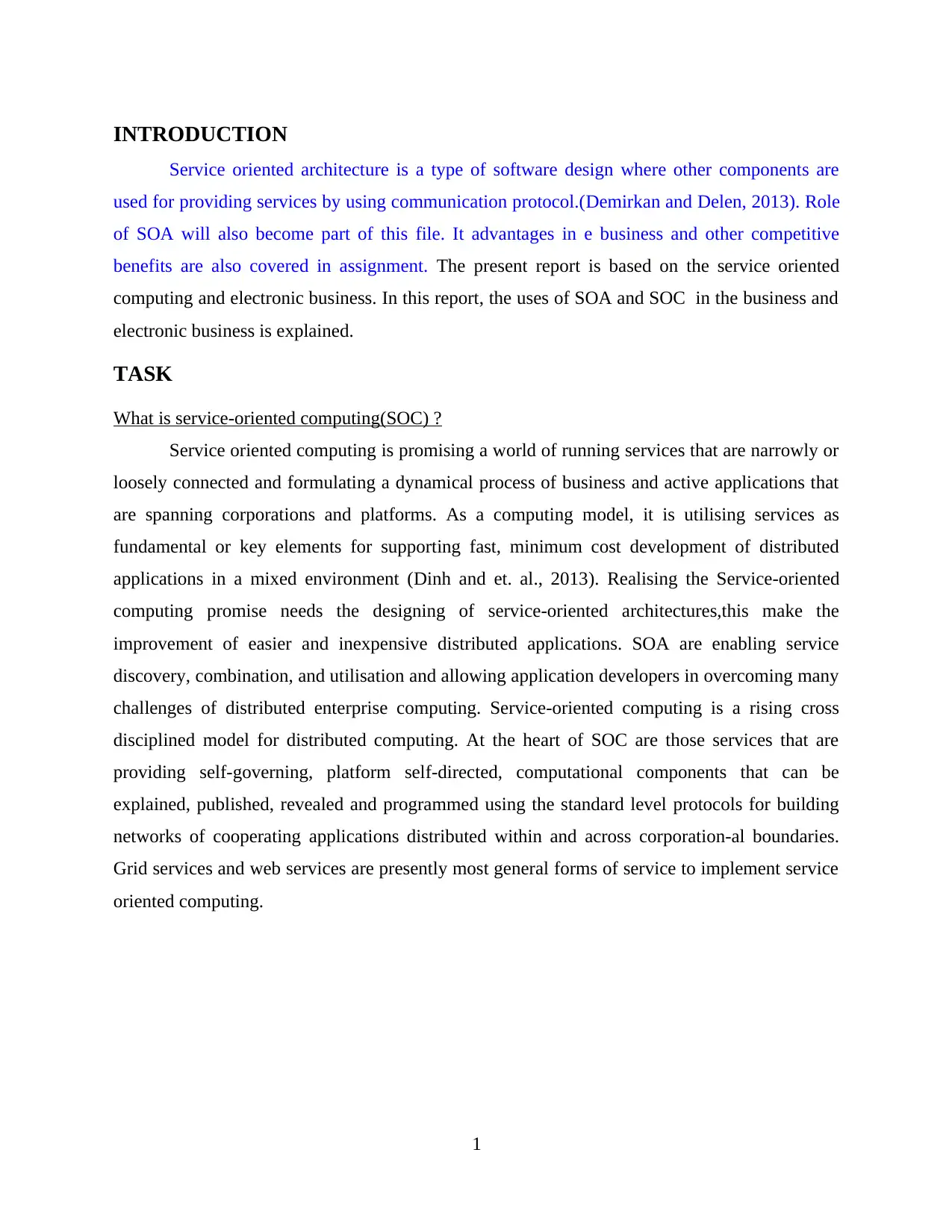
INTRODUCTION
Service oriented architecture is a type of software design where other components are
used for providing services by using communication protocol.(Demirkan and Delen, 2013). Role
of SOA will also become part of this file. It advantages in e business and other competitive
benefits are also covered in assignment. The present report is based on the service oriented
computing and electronic business. In this report, the uses of SOA and SOC in the business and
electronic business is explained.
TASK
What is service-oriented computing(SOC) ?
Service oriented computing is promising a world of running services that are narrowly or
loosely connected and formulating a dynamical process of business and active applications that
are spanning corporations and platforms. As a computing model, it is utilising services as
fundamental or key elements for supporting fast, minimum cost development of distributed
applications in a mixed environment (Dinh and et. al., 2013). Realising the Service-oriented
computing promise needs the designing of service-oriented architectures,this make the
improvement of easier and inexpensive distributed applications. SOA are enabling service
discovery, combination, and utilisation and allowing application developers in overcoming many
challenges of distributed enterprise computing. Service-oriented computing is a rising cross
disciplined model for distributed computing. At the heart of SOC are those services that are
providing self-governing, platform self-directed, computational components that can be
explained, published, revealed and programmed using the standard level protocols for building
networks of cooperating applications distributed within and across corporation-al boundaries.
Grid services and web services are presently most general forms of service to implement service
oriented computing.
1
Service oriented architecture is a type of software design where other components are
used for providing services by using communication protocol.(Demirkan and Delen, 2013). Role
of SOA will also become part of this file. It advantages in e business and other competitive
benefits are also covered in assignment. The present report is based on the service oriented
computing and electronic business. In this report, the uses of SOA and SOC in the business and
electronic business is explained.
TASK
What is service-oriented computing(SOC) ?
Service oriented computing is promising a world of running services that are narrowly or
loosely connected and formulating a dynamical process of business and active applications that
are spanning corporations and platforms. As a computing model, it is utilising services as
fundamental or key elements for supporting fast, minimum cost development of distributed
applications in a mixed environment (Dinh and et. al., 2013). Realising the Service-oriented
computing promise needs the designing of service-oriented architectures,this make the
improvement of easier and inexpensive distributed applications. SOA are enabling service
discovery, combination, and utilisation and allowing application developers in overcoming many
challenges of distributed enterprise computing. Service-oriented computing is a rising cross
disciplined model for distributed computing. At the heart of SOC are those services that are
providing self-governing, platform self-directed, computational components that can be
explained, published, revealed and programmed using the standard level protocols for building
networks of cooperating applications distributed within and across corporation-al boundaries.
Grid services and web services are presently most general forms of service to implement service
oriented computing.
1
⊘ This is a preview!⊘
Do you want full access?
Subscribe today to unlock all pages.

Trusted by 1+ million students worldwide
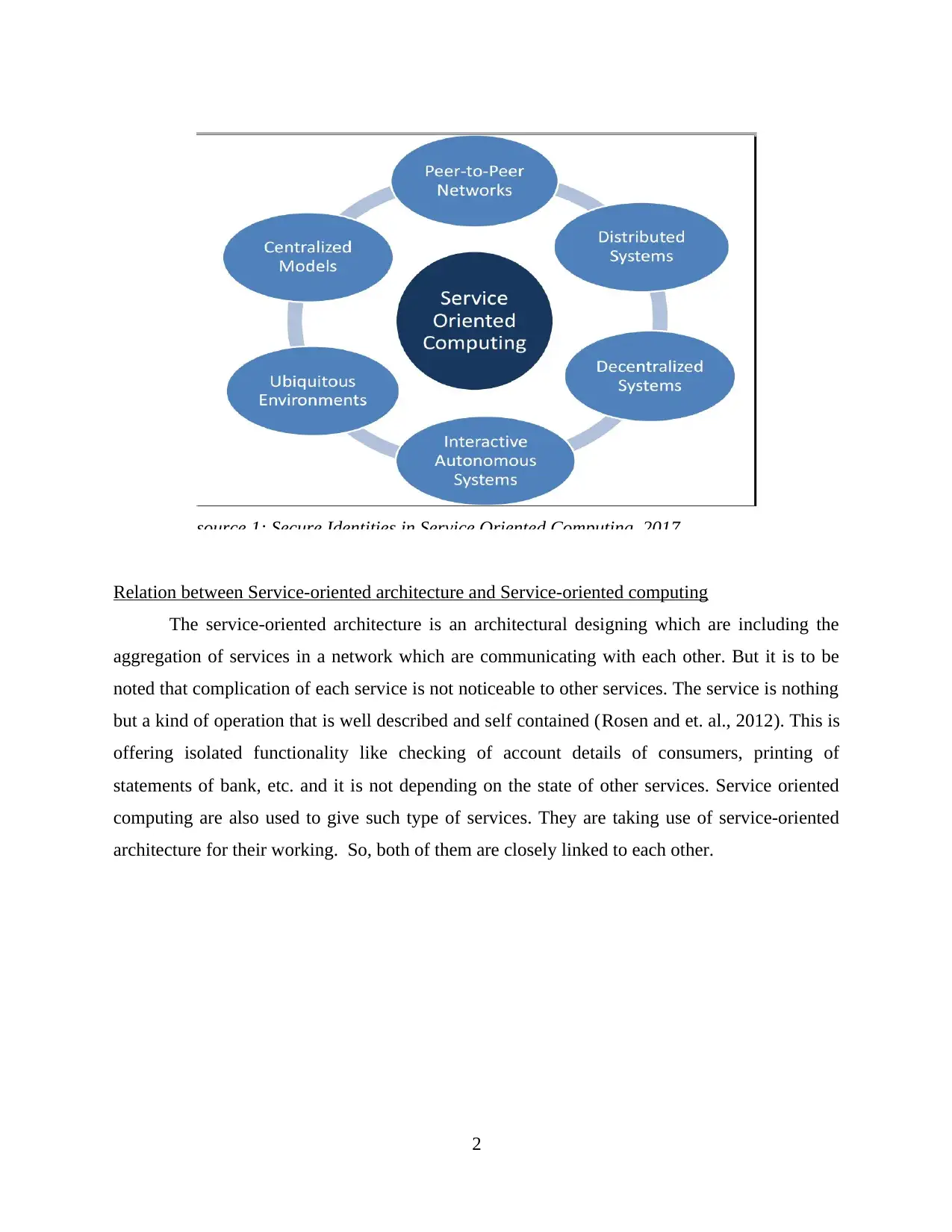
Relation between Service-oriented architecture and Service-oriented computing
The service-oriented architecture is an architectural designing which are including the
aggregation of services in a network which are communicating with each other. But it is to be
noted that complication of each service is not noticeable to other services. The service is nothing
but a kind of operation that is well described and self contained (Rosen and et. al., 2012). This is
offering isolated functionality like checking of account details of consumers, printing of
statements of bank, etc. and it is not depending on the state of other services. Service oriented
computing are also used to give such type of services. They are taking use of service-oriented
architecture for their working. So, both of them are closely linked to each other.
2
source 1: Secure Identities in Service Oriented Computing, 2017
The service-oriented architecture is an architectural designing which are including the
aggregation of services in a network which are communicating with each other. But it is to be
noted that complication of each service is not noticeable to other services. The service is nothing
but a kind of operation that is well described and self contained (Rosen and et. al., 2012). This is
offering isolated functionality like checking of account details of consumers, printing of
statements of bank, etc. and it is not depending on the state of other services. Service oriented
computing are also used to give such type of services. They are taking use of service-oriented
architecture for their working. So, both of them are closely linked to each other.
2
source 1: Secure Identities in Service Oriented Computing, 2017
Paraphrase This Document
Need a fresh take? Get an instant paraphrase of this document with our AI Paraphraser
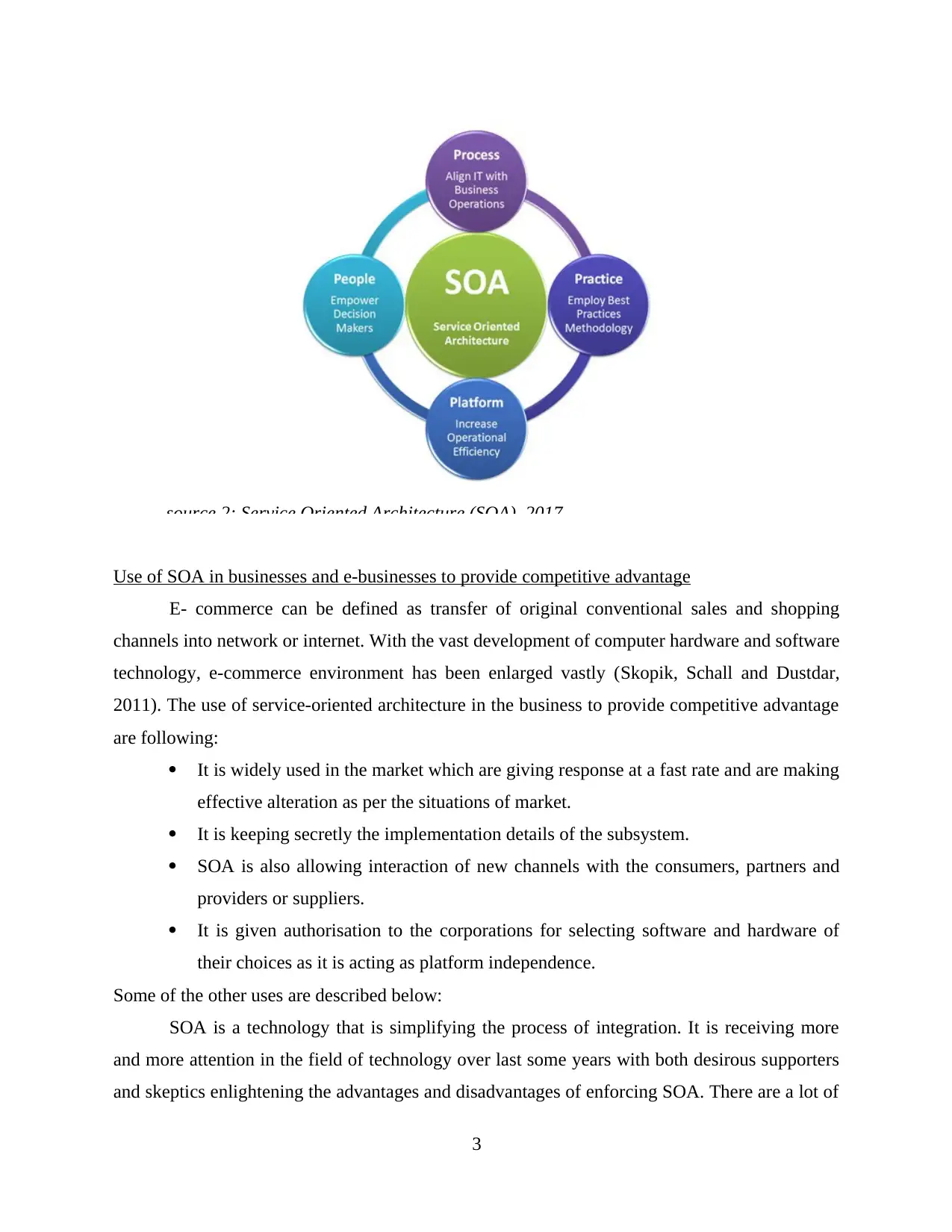
Use of SOA in businesses and e-businesses to provide competitive advantage
E- commerce can be defined as transfer of original conventional sales and shopping
channels into network or internet. With the vast development of computer hardware and software
technology, e-commerce environment has been enlarged vastly (Skopik, Schall and Dustdar,
2011). The use of service-oriented architecture in the business to provide competitive advantage
are following:
It is widely used in the market which are giving response at a fast rate and are making
effective alteration as per the situations of market.
It is keeping secretly the implementation details of the subsystem.
SOA is also allowing interaction of new channels with the consumers, partners and
providers or suppliers.
It is given authorisation to the corporations for selecting software and hardware of
their choices as it is acting as platform independence.
Some of the other uses are described below:
SOA is a technology that is simplifying the process of integration. It is receiving more
and more attention in the field of technology over last some years with both desirous supporters
and skeptics enlightening the advantages and disadvantages of enforcing SOA. There are a lot of
3
source 2: Service Oriented Architecture (SOA), 2017
E- commerce can be defined as transfer of original conventional sales and shopping
channels into network or internet. With the vast development of computer hardware and software
technology, e-commerce environment has been enlarged vastly (Skopik, Schall and Dustdar,
2011). The use of service-oriented architecture in the business to provide competitive advantage
are following:
It is widely used in the market which are giving response at a fast rate and are making
effective alteration as per the situations of market.
It is keeping secretly the implementation details of the subsystem.
SOA is also allowing interaction of new channels with the consumers, partners and
providers or suppliers.
It is given authorisation to the corporations for selecting software and hardware of
their choices as it is acting as platform independence.
Some of the other uses are described below:
SOA is a technology that is simplifying the process of integration. It is receiving more
and more attention in the field of technology over last some years with both desirous supporters
and skeptics enlightening the advantages and disadvantages of enforcing SOA. There are a lot of
3
source 2: Service Oriented Architecture (SOA), 2017
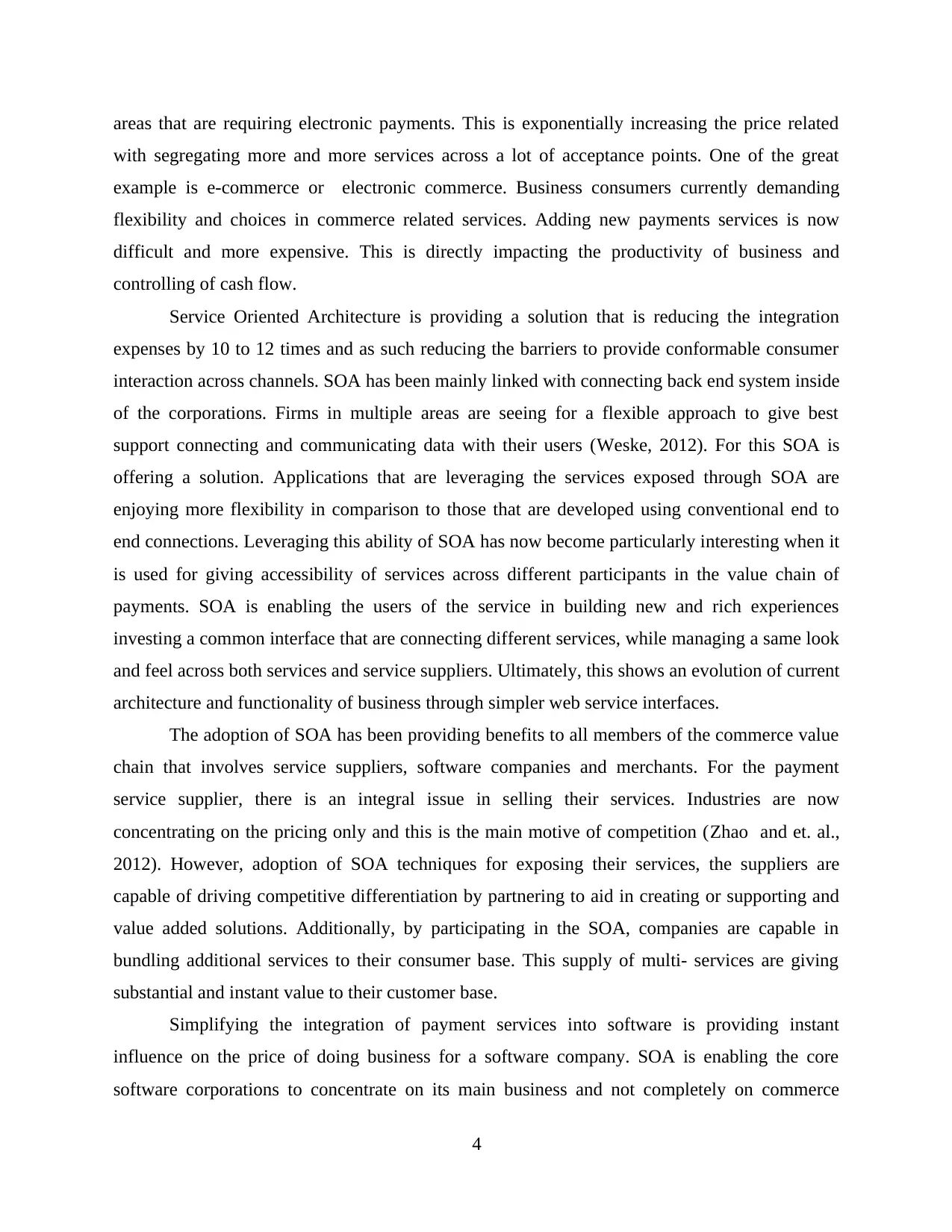
areas that are requiring electronic payments. This is exponentially increasing the price related
with segregating more and more services across a lot of acceptance points. One of the great
example is e-commerce or electronic commerce. Business consumers currently demanding
flexibility and choices in commerce related services. Adding new payments services is now
difficult and more expensive. This is directly impacting the productivity of business and
controlling of cash flow.
Service Oriented Architecture is providing a solution that is reducing the integration
expenses by 10 to 12 times and as such reducing the barriers to provide conformable consumer
interaction across channels. SOA has been mainly linked with connecting back end system inside
of the corporations. Firms in multiple areas are seeing for a flexible approach to give best
support connecting and communicating data with their users (Weske, 2012). For this SOA is
offering a solution. Applications that are leveraging the services exposed through SOA are
enjoying more flexibility in comparison to those that are developed using conventional end to
end connections. Leveraging this ability of SOA has now become particularly interesting when it
is used for giving accessibility of services across different participants in the value chain of
payments. SOA is enabling the users of the service in building new and rich experiences
investing a common interface that are connecting different services, while managing a same look
and feel across both services and service suppliers. Ultimately, this shows an evolution of current
architecture and functionality of business through simpler web service interfaces.
The adoption of SOA has been providing benefits to all members of the commerce value
chain that involves service suppliers, software companies and merchants. For the payment
service supplier, there is an integral issue in selling their services. Industries are now
concentrating on the pricing only and this is the main motive of competition (Zhao and et. al.,
2012). However, adoption of SOA techniques for exposing their services, the suppliers are
capable of driving competitive differentiation by partnering to aid in creating or supporting and
value added solutions. Additionally, by participating in the SOA, companies are capable in
bundling additional services to their consumer base. This supply of multi- services are giving
substantial and instant value to their customer base.
Simplifying the integration of payment services into software is providing instant
influence on the price of doing business for a software company. SOA is enabling the core
software corporations to concentrate on its main business and not completely on commerce
4
with segregating more and more services across a lot of acceptance points. One of the great
example is e-commerce or electronic commerce. Business consumers currently demanding
flexibility and choices in commerce related services. Adding new payments services is now
difficult and more expensive. This is directly impacting the productivity of business and
controlling of cash flow.
Service Oriented Architecture is providing a solution that is reducing the integration
expenses by 10 to 12 times and as such reducing the barriers to provide conformable consumer
interaction across channels. SOA has been mainly linked with connecting back end system inside
of the corporations. Firms in multiple areas are seeing for a flexible approach to give best
support connecting and communicating data with their users (Weske, 2012). For this SOA is
offering a solution. Applications that are leveraging the services exposed through SOA are
enjoying more flexibility in comparison to those that are developed using conventional end to
end connections. Leveraging this ability of SOA has now become particularly interesting when it
is used for giving accessibility of services across different participants in the value chain of
payments. SOA is enabling the users of the service in building new and rich experiences
investing a common interface that are connecting different services, while managing a same look
and feel across both services and service suppliers. Ultimately, this shows an evolution of current
architecture and functionality of business through simpler web service interfaces.
The adoption of SOA has been providing benefits to all members of the commerce value
chain that involves service suppliers, software companies and merchants. For the payment
service supplier, there is an integral issue in selling their services. Industries are now
concentrating on the pricing only and this is the main motive of competition (Zhao and et. al.,
2012). However, adoption of SOA techniques for exposing their services, the suppliers are
capable of driving competitive differentiation by partnering to aid in creating or supporting and
value added solutions. Additionally, by participating in the SOA, companies are capable in
bundling additional services to their consumer base. This supply of multi- services are giving
substantial and instant value to their customer base.
Simplifying the integration of payment services into software is providing instant
influence on the price of doing business for a software company. SOA is enabling the core
software corporations to concentrate on its main business and not completely on commerce
4
⊘ This is a preview!⊘
Do you want full access?
Subscribe today to unlock all pages.

Trusted by 1+ million students worldwide
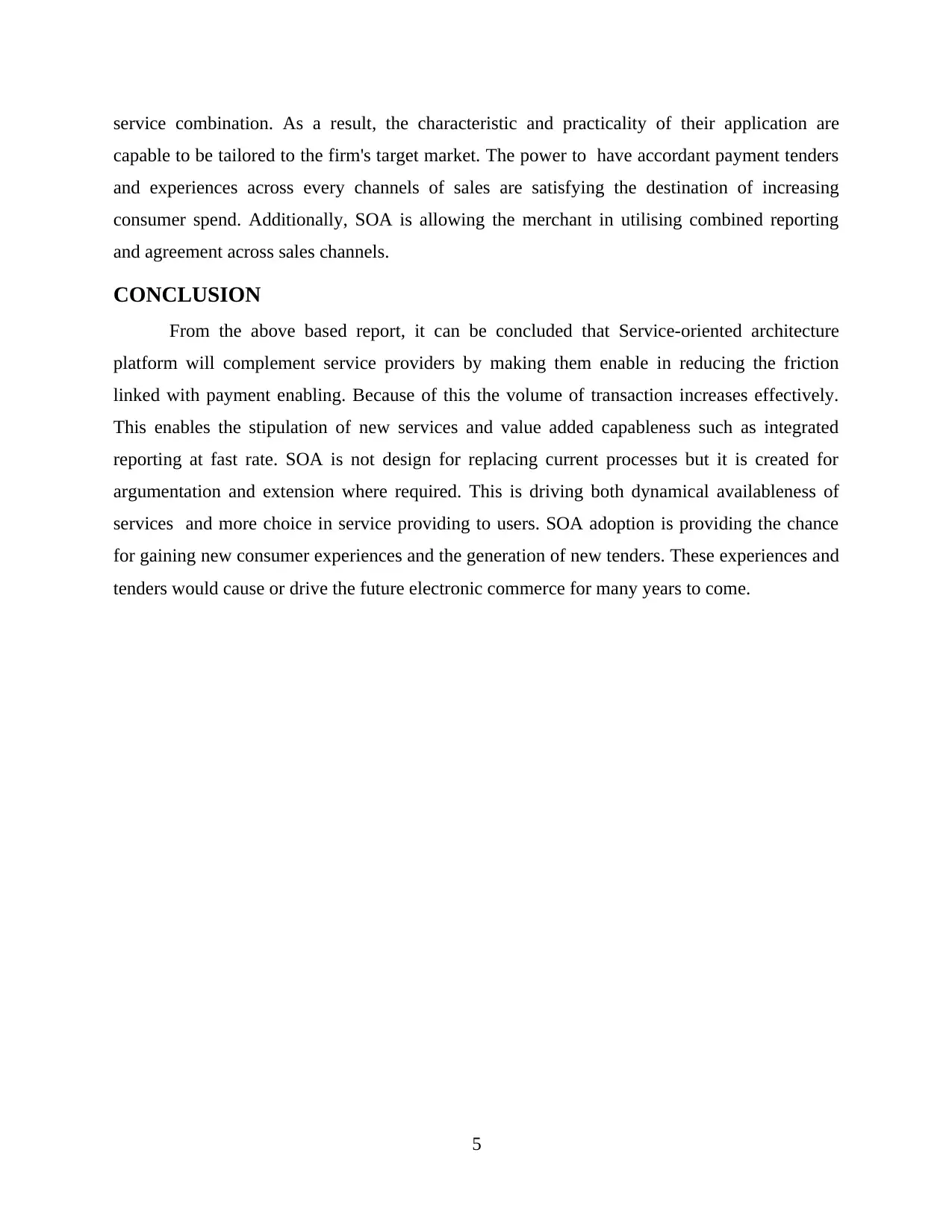
service combination. As a result, the characteristic and practicality of their application are
capable to be tailored to the firm's target market. The power to have accordant payment tenders
and experiences across every channels of sales are satisfying the destination of increasing
consumer spend. Additionally, SOA is allowing the merchant in utilising combined reporting
and agreement across sales channels.
CONCLUSION
From the above based report, it can be concluded that Service-oriented architecture
platform will complement service providers by making them enable in reducing the friction
linked with payment enabling. Because of this the volume of transaction increases effectively.
This enables the stipulation of new services and value added capableness such as integrated
reporting at fast rate. SOA is not design for replacing current processes but it is created for
argumentation and extension where required. This is driving both dynamical availableness of
services and more choice in service providing to users. SOA adoption is providing the chance
for gaining new consumer experiences and the generation of new tenders. These experiences and
tenders would cause or drive the future electronic commerce for many years to come.
5
capable to be tailored to the firm's target market. The power to have accordant payment tenders
and experiences across every channels of sales are satisfying the destination of increasing
consumer spend. Additionally, SOA is allowing the merchant in utilising combined reporting
and agreement across sales channels.
CONCLUSION
From the above based report, it can be concluded that Service-oriented architecture
platform will complement service providers by making them enable in reducing the friction
linked with payment enabling. Because of this the volume of transaction increases effectively.
This enables the stipulation of new services and value added capableness such as integrated
reporting at fast rate. SOA is not design for replacing current processes but it is created for
argumentation and extension where required. This is driving both dynamical availableness of
services and more choice in service providing to users. SOA adoption is providing the chance
for gaining new consumer experiences and the generation of new tenders. These experiences and
tenders would cause or drive the future electronic commerce for many years to come.
5
Paraphrase This Document
Need a fresh take? Get an instant paraphrase of this document with our AI Paraphraser
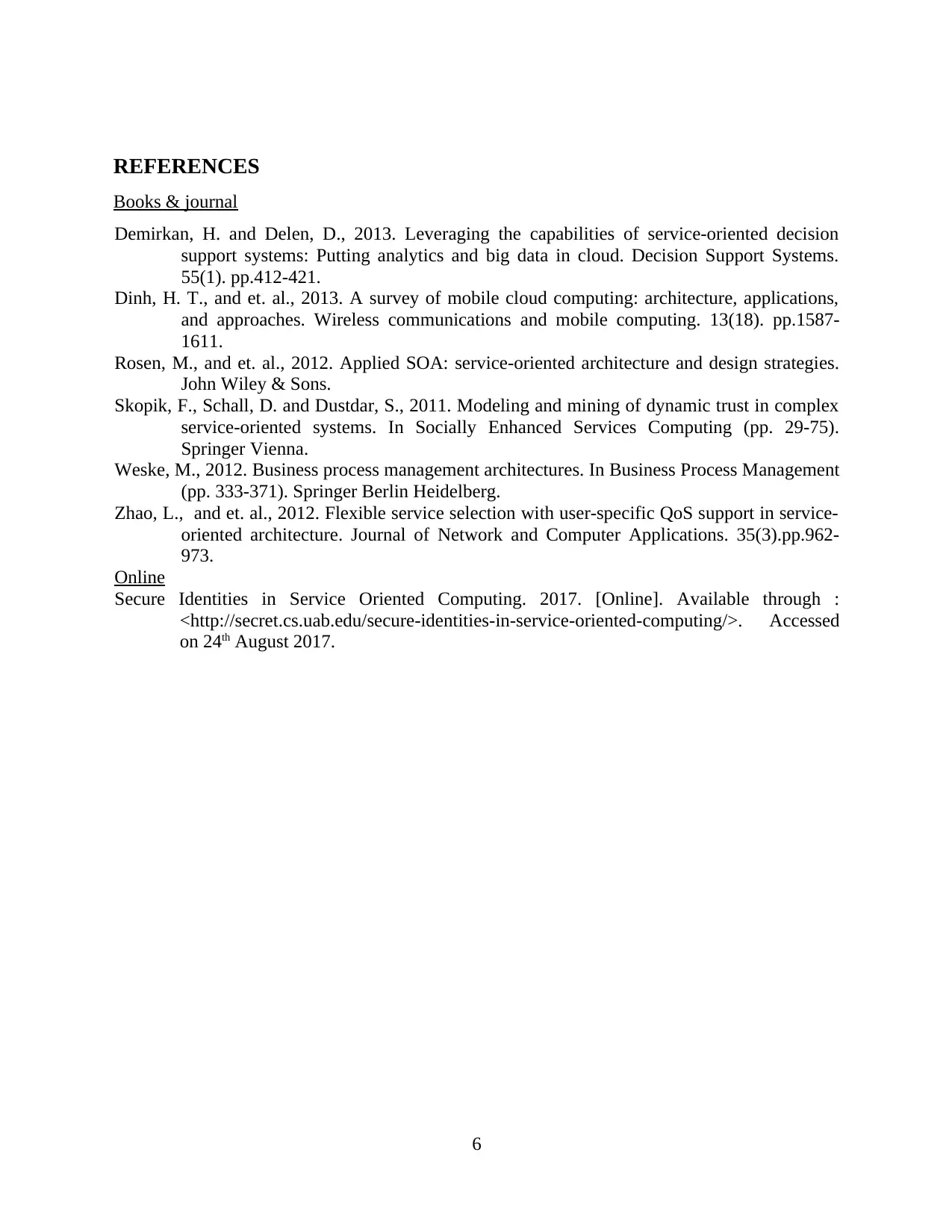
REFERENCES
Books & journal
Demirkan, H. and Delen, D., 2013. Leveraging the capabilities of service-oriented decision
support systems: Putting analytics and big data in cloud. Decision Support Systems.
55(1). pp.412-421.
Dinh, H. T., and et. al., 2013. A survey of mobile cloud computing: architecture, applications,
and approaches. Wireless communications and mobile computing. 13(18). pp.1587-
1611.
Rosen, M., and et. al., 2012. Applied SOA: service-oriented architecture and design strategies.
John Wiley & Sons.
Skopik, F., Schall, D. and Dustdar, S., 2011. Modeling and mining of dynamic trust in complex
service-oriented systems. In Socially Enhanced Services Computing (pp. 29-75).
Springer Vienna.
Weske, M., 2012. Business process management architectures. In Business Process Management
(pp. 333-371). Springer Berlin Heidelberg.
Zhao, L., and et. al., 2012. Flexible service selection with user-specific QoS support in service-
oriented architecture. Journal of Network and Computer Applications. 35(3).pp.962-
973.
Online
Secure Identities in Service Oriented Computing. 2017. [Online]. Available through :
<http://secret.cs.uab.edu/secure-identities-in-service-oriented-computing/>. Accessed
on 24th August 2017.
6
Books & journal
Demirkan, H. and Delen, D., 2013. Leveraging the capabilities of service-oriented decision
support systems: Putting analytics and big data in cloud. Decision Support Systems.
55(1). pp.412-421.
Dinh, H. T., and et. al., 2013. A survey of mobile cloud computing: architecture, applications,
and approaches. Wireless communications and mobile computing. 13(18). pp.1587-
1611.
Rosen, M., and et. al., 2012. Applied SOA: service-oriented architecture and design strategies.
John Wiley & Sons.
Skopik, F., Schall, D. and Dustdar, S., 2011. Modeling and mining of dynamic trust in complex
service-oriented systems. In Socially Enhanced Services Computing (pp. 29-75).
Springer Vienna.
Weske, M., 2012. Business process management architectures. In Business Process Management
(pp. 333-371). Springer Berlin Heidelberg.
Zhao, L., and et. al., 2012. Flexible service selection with user-specific QoS support in service-
oriented architecture. Journal of Network and Computer Applications. 35(3).pp.962-
973.
Online
Secure Identities in Service Oriented Computing. 2017. [Online]. Available through :
<http://secret.cs.uab.edu/secure-identities-in-service-oriented-computing/>. Accessed
on 24th August 2017.
6

7
⊘ This is a preview!⊘
Do you want full access?
Subscribe today to unlock all pages.

Trusted by 1+ million students worldwide

8
1 out of 10
Related Documents
Your All-in-One AI-Powered Toolkit for Academic Success.
+13062052269
info@desklib.com
Available 24*7 on WhatsApp / Email
![[object Object]](/_next/static/media/star-bottom.7253800d.svg)
Unlock your academic potential
Copyright © 2020–2025 A2Z Services. All Rights Reserved. Developed and managed by ZUCOL.




